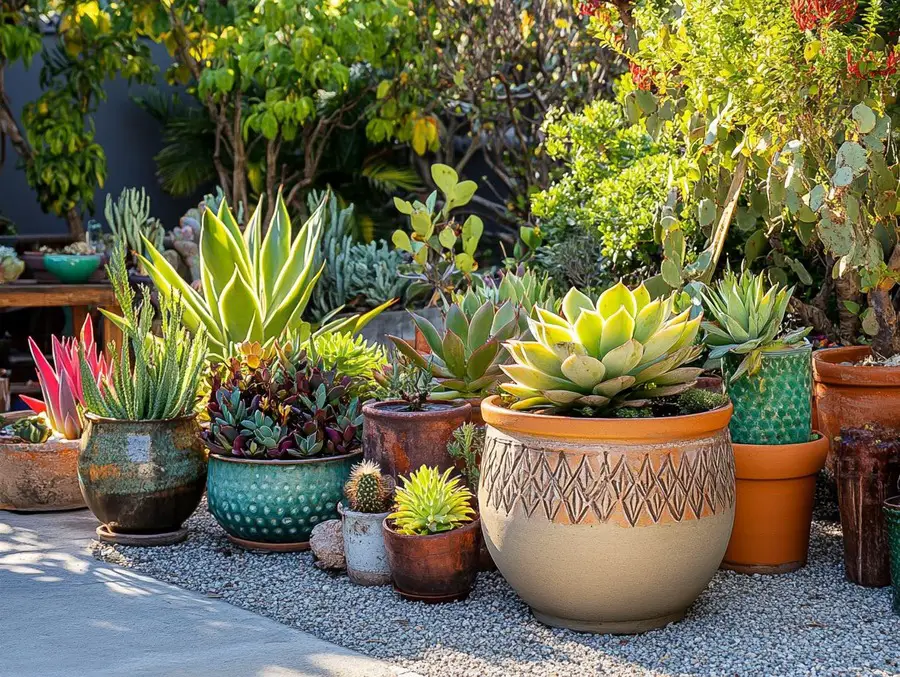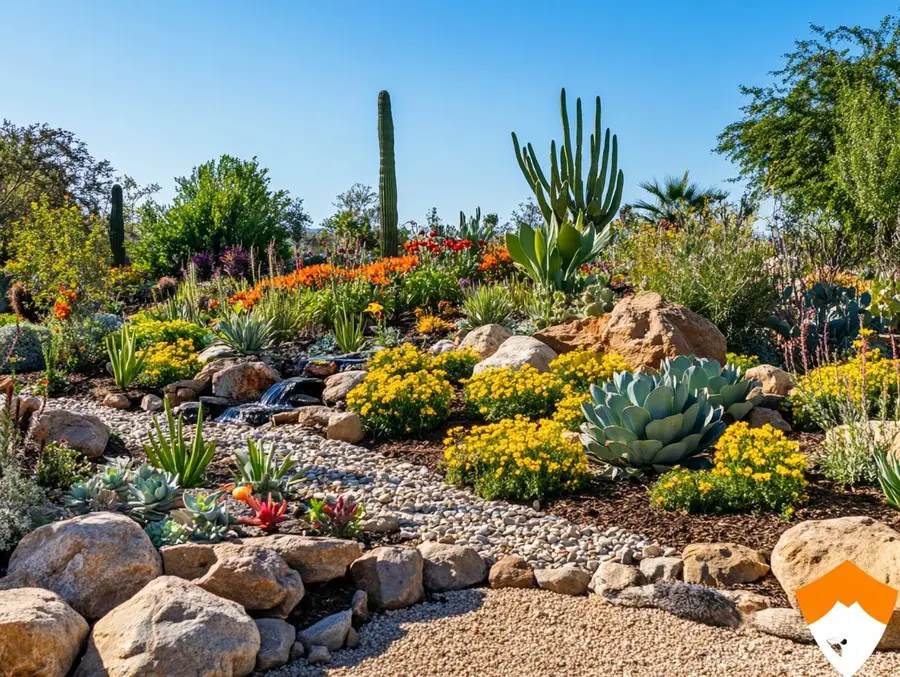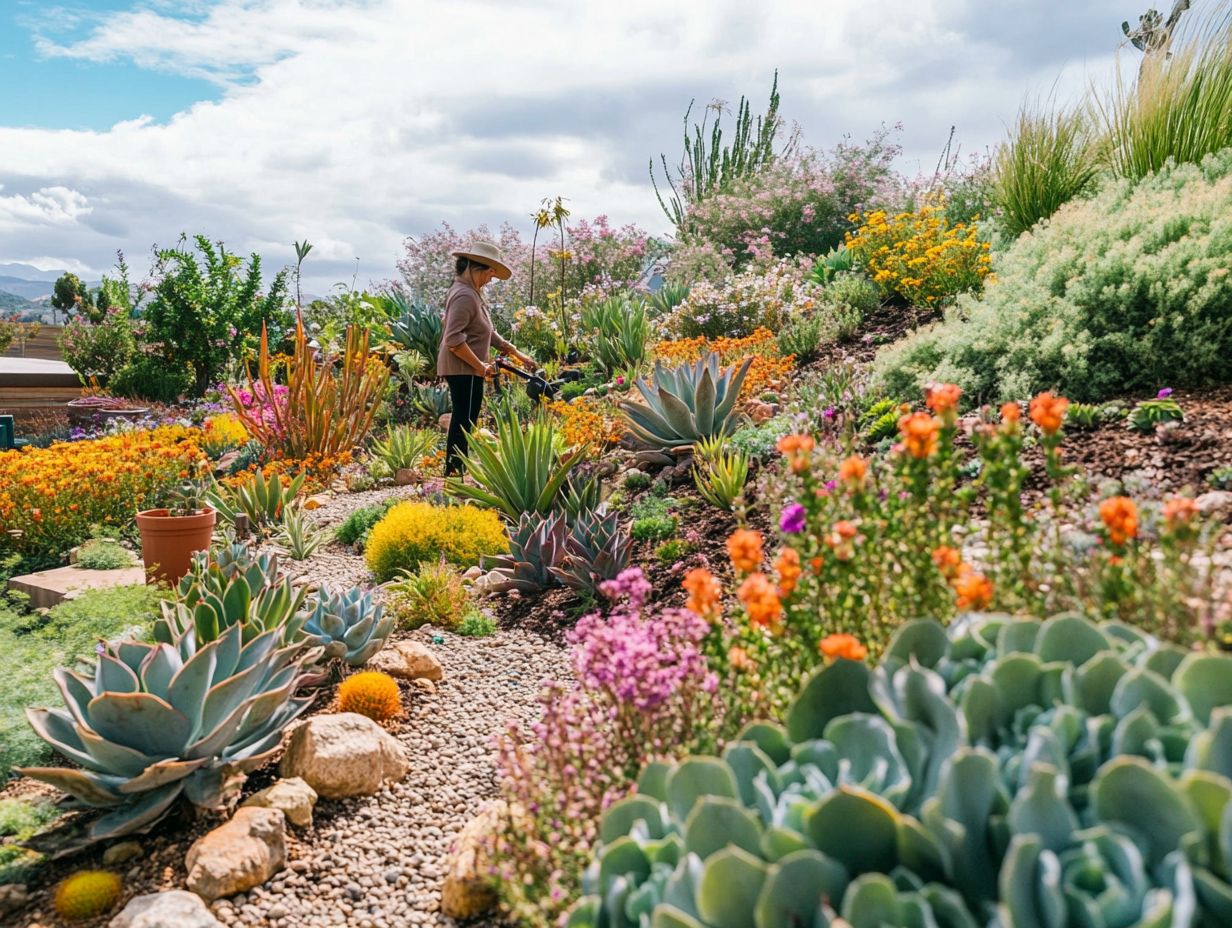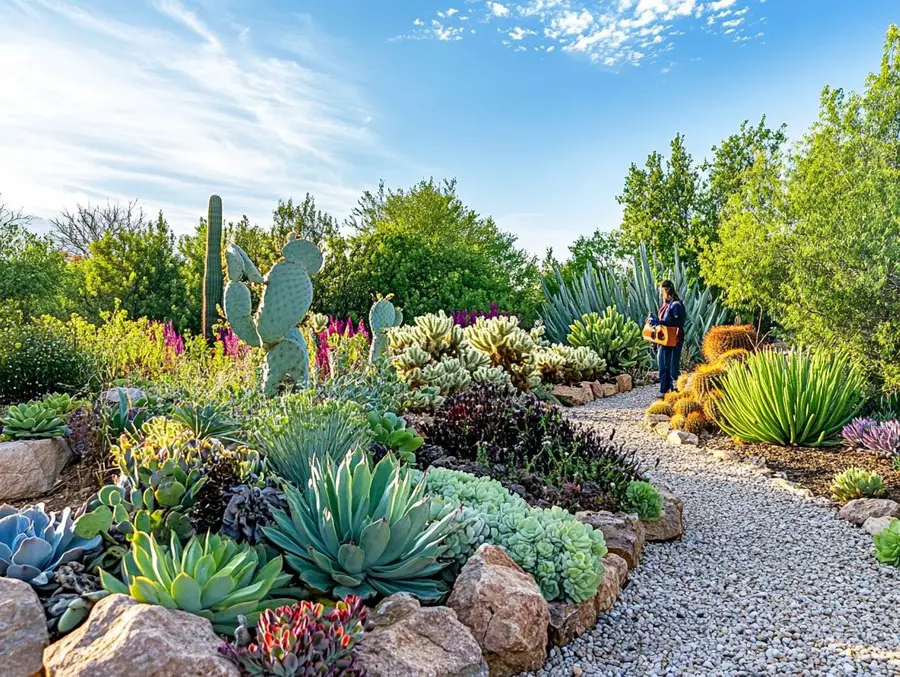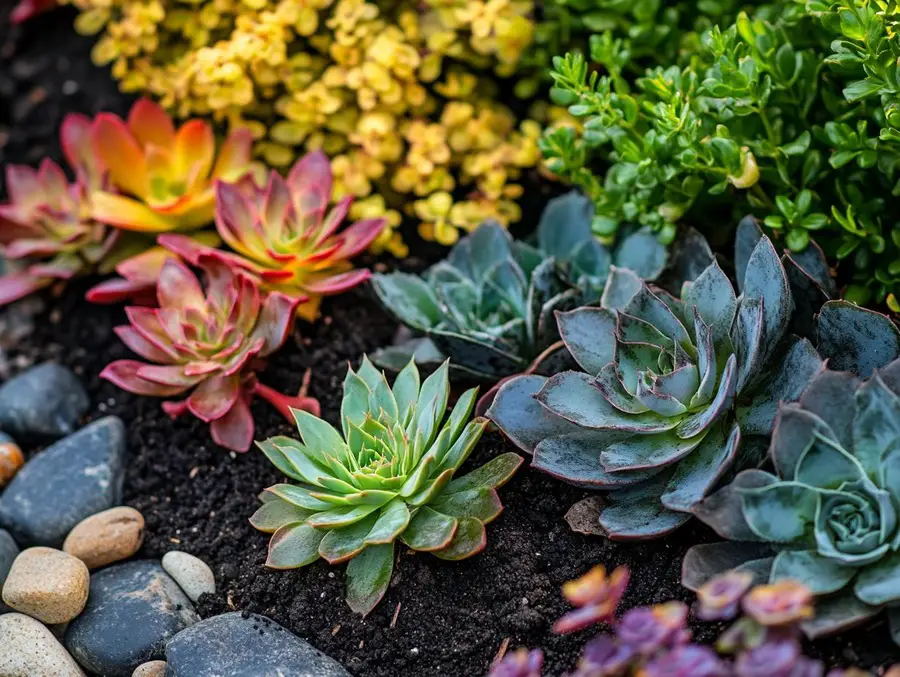We use affiliate links. If you purchase something using one of these links, we may receive compensation or commission.
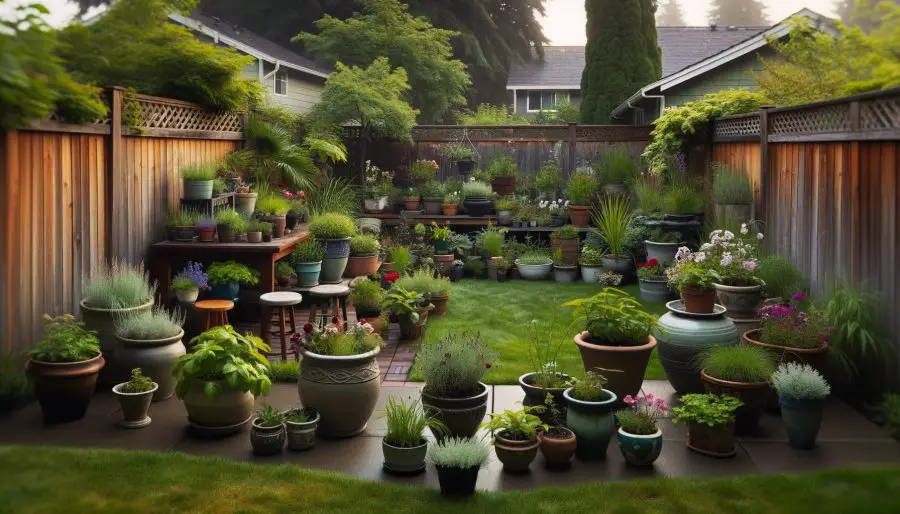 Discover easy-to-follow Container Gardening tips for a thriving garden in any space! Get practical advice on plants, soil, and care.
Discover easy-to-follow Container Gardening tips for a thriving garden in any space! Get practical advice on plants, soil, and care.
Container Gardening Tips Key Takeaways:
- Container Gardening tips include choosing the right containers
- Using a quality potting mix
- Selecting suitable plants
- Ensure adequate watering and sunlight for your plants to thrive in their container environment.
Ready to transform your balcony or patio into a blooming oasis?
Our Container Gardening tips guide you through creating and maintaining a vibrant garden in even the smallest of spaces.
We will give you some container garden ideas too.
Let’s dig in and make those plant dreams a reality!
Mastering Container Gardening: A Comprehensive Guide
Container gardening is a delightful and practical way to bring greenery into any space, large or small.
Whether you’re working with a sprawling patio or a modest windowsill, understanding the fundamentals of container gardening can transform your approach to plant care and garden design.
In this guide, we’ll explore the critical aspects of container gardening, from choosing the right containers to understanding soil and water needs.
By mastering these container gardening basics, you’ll be well-equipped to create and maintain a thriving, vibrant garden in any container.
Container gardening or pot gardening/farming is the practice of growing plants, including edible plants, exclusively in containers instead of planting them in the ground. A container in gardening is a small, enclosed and usually portable object used for displaying live flowers or plants. It may take the form of a pot, box, tub, basket, tin, barrel or hanging basket. Wikipedia
Fundamentals of Container Gardening
Container gardening is an accessible and rewarding hobby, perfect for those with limited space or who want to add a touch of nature to their living areas.
This section of the guide delves into the essentials of container gardening.
It covers the foundational elements such as selecting the appropriate containers, understanding the significance of quality potting mixes, and choosing the right plants to suit your space and aesthetic preferences.
Additionally, it addresses crucial practices like effective water management and ensuring adequate sunlight, which is vital for the health and growth of your container plants.
By grasping these basic principles, you will be well on your way to creating a successful and beautiful container garden.
Choosing the Right Containers
Selecting the right container is the foundation of successful container gardening.
It involves considering the size, material, and style of the container, which are crucial for the health and growth of your plants.
Let’s explore how to make the best choice for your gardening needs.
Size Considerations
- Size plays a critical role in container gardening. The container size should match the mature size of the plant, allowing enough room for root development.
- Large containers provide more soil volume and moisture retention, benefiting plants with higher water requirements.
- Conversely, small containers suit compact plants or those preferring confined root spaces.
Material Types
Containers come in various materials like plastic, clay, ceramic, and wood, each with unique advantages.
Plastic containers are lightweight and affordable, while clay or terracotta offers good breathability but may dry out faster.
Ceramic containers retain moisture well but are heavier. Wooden containers provide excellent insulation but may require more maintenance.
Each material impacts the watering needs and overall health of the plants.
Style and Aesthetic Impact
The style of your containers should complement your personal taste and the design of your outdoor or indoor space.
Container styles range from modern and sleek to traditional and rustic, offering numerous options to match any gardening theme.
The right style not only supports plant health but also enhances the visual appeal of your garden.
Quality Potting Mixes
A good potting mix is essential for container gardening. It provides the necessary support, nutrients, and moisture control for your plants.
Understanding the components of potting mixes and their roles in plant health is crucial for creating a thriving container garden.
Understanding Potting Mix Components
- High-quality potting mixes usually contain peat moss, vermiculite, perlite, and compost.
- Each component serves a specific purpose, like ensuring moisture retention, aeration, and providing essential nutrients.
- Peat moss offers moisture retention, while perlite ensures good drainage. Vermiculite aids in water retention and nutrient supply, and compost adds organic matter and beneficial microbes to the mix.
- Coco coir and perlite mixes offer a more environmentally friendly and sustainable approach to using peat moss soil mixes
Avoiding Garden Soil and Amending Potting Mixes
- Using garden soil in containers is not recommended due to potential issues like poor drainage and disease.
- Instead, use specially formulated potting mixes, and consider amending them with organic matter or slow-release fertilizers for improved nutrient content and water-holding capacity.
Selecting Plants for Containers
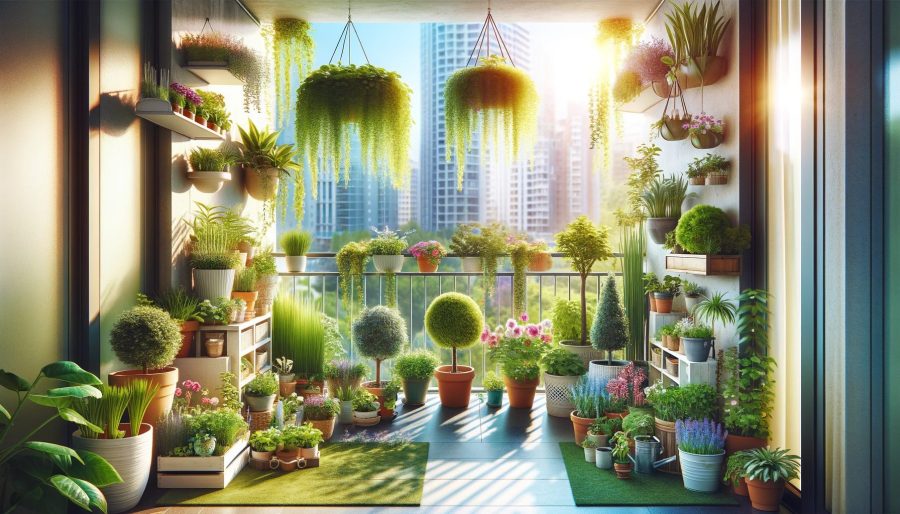
Selecting the right plants for your containers is both an art and a science.
This crucial step sets the foundation for a thriving container garden. Whether you’re aiming for a vibrant floral display, a fresh herb collection, or a mix of ornamental and edible plants, choosing plants that are well-suited to container life is key.
In this guide, we’ll explore how to pick plants that not only grow well in limited space but also bring the desired aesthetic and functional qualities to your garden.
Let’s embark on this green journey to find the perfect plants for your container garden!
Thrillers, Spillers, and Fillers: Creating Visual Appeal
- A well-designed container garden typically includes thrillers (eye-catching centerpiece plants), spillers (plants that cascade over the container’s edges), and fillers (plants that add body and fullness).
- Selecting the right combination of these plant types can create an aesthetically pleasing and balanced container garden.
I have created a table showcasing examples of Thrillers, Spillers, and Fillers for container gardening:
| Thrillers | Spillers | Fillers |
|---|---|---|
| Tall ornamental grasses | Ivy (Hedera spp.) | Geraniums (Pelargonium spp.) |
| Cannas | Trailing Petunias | Coleus (Solenostemon scutellarioides) |
| Cordyline | Creeping Jenny (Lysimachia nummularia) | Marigolds (Tagetes spp.) |
| Dracaena | Bacopa (Sutera cordata) | Lobelia (Lobelia erinus) |
| Upright herbs (e.g., Rosemary) | Trailing herbs (e.g., Thyme) | Bushy herbs (e.g., Basil) |
This table provides examples of plants that can be used as thrillers (tall and eye-catching), spillers (trailing or cascading), and fillers (adding volume and texture) in a container garden.
Matching Plant Needs with Container Size and Conditions
- It’s important to match the plant’s needs with the container size and environmental conditions.
- Consider factors like sunlight exposure, watering requirements, and growth habits. This ensures that your plants are well-suited to their containers and are more likely to thrive.
Water Management
Effective water management is essential in container gardening.
Unlike in-ground gardens, containers have limited soil, affecting how water is retained and distributed.
Let’s delve into the crucial aspects of water management to ensure your plants thrive.
Monitoring Soil Moisture Levels
Regularly check the soil’s moisture by inserting a finger up to the second knuckle. If the soil feels dry at that depth, it’s time to water.
Overwatering can be as harmful as underwatering, causing root rot.
Striking a balance is key, allowing the soil to slightly dry out between watering sessions while ensuring consistent moisture to support plant growth.
Deep and Thorough Watering Techniques
Watering should saturate the entire root ball, encouraging deep root growth.
Apply water until it drains out of the bottom of the container, avoiding shallow watering that leads to weak root systems.
Tools like a watering can with a narrow spout offer precision, ensuring water reaches the roots without waste.
In hotter climates or during peak summer, adjust the frequency of watering to accommodate increased evaporation.
Mulching for Moisture Retention
Mulching is a beneficial practice in container gardening. It helps retain moisture, reduces water evaporation, and moderates soil temperature.
- Organic mulches like wood chips or straw can be applied to the soil surface, enhancing moisture retention.
- Ensure a balanced application to prevent mold or fungal growth, and replenish the mulch as needed to maintain its effectiveness.
Ensuring Adequate Sunlight
Sunlight is vital for photosynthesis and the overall health of your plants.
Understanding and managing sunlight exposure can make a significant difference in the success of your container garden.
Assessing Plants’ Sunlight Requirements
Different plants have varying sunlight needs, ranging from full sun to partial shade.
Full-sun plants need a minimum of six to eight hours of direct sunlight daily, while shade-tolerant plants require less.
Research each plant’s sunlight requirements, considering factors like the intensity and duration of exposure.
This knowledge will guide you in selecting the right plants for your garden’s light conditions and ensure their optimal growth.
Adjusting Container Positioning
Observe the sunlight patterns in your garden throughout the day. Place containers in locations that match the plants’ sunlight needs.
For instance, full-sun plants should be in south-facing areas, while partial-shade plants might thrive in east or west-facing locations with some afternoon shade.
As seasons change, be prepared to adjust the positioning of your containers to align with the shifting sunlight, ensuring your plants receive the appropriate amount of light all year round.
Advanced Container Gardening Techniques
Advancing your container gardening skills involves delving deeper into the nuances of plant care and maintenance.
In this section, we focus on more sophisticated aspects such as proper nutrition and fertilization, pruning and ongoing maintenance, and managing pests and diseases.
These advanced techniques are essential for ensuring the long-term health and vibrancy of your container garden.
By understanding and implementing these practices, you can elevate your gardening experience, leading to lush, healthy plants and a more rewarding gardening journey.
Nutrition and Fertilization
Proper nutrition is a cornerstone of a thriving container garden. Plants in containers rely entirely on their potting mix and added fertilizers for their nutritional needs.
Here’s how to effectively nourish your plants:
Balanced Fertilization
Container plants require a balanced supply of essential nutrients: nitrogen, phosphorus, and potassium, commonly referred to as NPK.
A balanced fertilizer ensures that plants receive an adequate amount of each essential nutrient.
- Choose a fertilizer with an appropriate NPK ratio for your plants, and consider the type (granular, liquid, or slow-release) based on the plant’s growth stage and needs.
Over-fertilization can be detrimental, so adhere to the recommended dosage and frequency.
- Remember, aside from NPK, plants also benefit from secondary nutrients and micronutrients, which are often present in comprehensive fertilizers or organic options like compost and worm castings.
Organic Fertilization
For gardeners preferring an eco-friendly approach, organic fertilizers offer slow-release nutrients, enrich the soil, and support a thriving ecosystem in your container.
Compost, worm castings, and fish emulsion are excellent organic choices.
These not only supply essential nutrients but also improve soil structure and promote beneficial microbial activity.
When incorporating organic fertilizers, remember they typically have lower nutrient concentrations than synthetic ones, so they may require more frequent applications.
Pruning and Maintenance
Regular pruning and maintenance are essential for the health and appearance of your container garden.
Here’s how to keep your plants looking their best:
Regular Pruning
Pruning helps control plant size, encourages bushier growth, and removes dead or diseased foliage, which can impede plant health.
Regularly inspect your plants and prune them as necessary, using clean, sharp tools to make precise cuts.
This not only keeps your plants looking tidy but also encourages new growth and can increase flower and fruit production.
Container Care
Proper container care includes cleaning and sanitizing containers between plantings to prevent disease spread.
Choose containers that accommodate the mature size of the plant, considering both above and below the soil.
Some plants prefer more confined spaces, while others require ample room for root growth.
Periodically check containers for cracks or damage, especially those exposed to harsh weather conditions.
Make sure all containers have drainage holes and that they are not blocked.
Pest and Disease Management
A healthy container garden often faces challenges from pests and diseases. Effective management is key to maintaining plant health:
Identifying Common Pests and Diseases
- Regularly inspect your plants for signs of pests or diseases. Common pests include aphids, spider mites, and slugs, while diseases might manifest as mold, mildew, or leaf spots.
- Early identification is crucial for effective control.
Control Methods
- Implement preventive measures such as proper spacing and avoiding overhead watering to reduce disease risk.
- For pests, using natural predators, neem oil, or insecticidal soap can be effective.
- In cases of severe infestations or diseases, chemical treatments may be necessary. Always follow the manufacturer’s guidelines when using these products.
Experimentation and Enjoyment
The true joy of container gardening lies in experimentation and the pleasure of watching your garden grow:
Embracing Trial and Error
Not every plant or method will work perfectly in your container garden, and that’s okay.
Experiment with different plants, container styles, and gardening techniques.
Learn from your successes and failures, and don’t be afraid to try new things.
Enjoying the Journey
Remember that container gardening is a journey, not just a destination.
Take time to enjoy the process of nurturing your plants, observing their growth, and reveling in the beauty they bring to your space.
Gardening is a rewarding hobby that offers endless opportunities for learning and enjoyment.
Expanding Container Gardening Knowledge
Welcome to the exciting journey of expanding your container gardening knowledge!
Whether you’re a seasoned gardener or just starting, this guide is designed to deepen your understanding and skills.
We’ll delve into advanced tips and creative ideas, helping you cultivate a lush, thriving garden in the smallest of spaces.
From balconies to windowsills, get ready to explore the endless possibilities and joys of container gardening.
Seasonal Considerations in Container Gardening
Seasonal changes significantly impact container gardening.
Understanding these changes ensures your garden remains vibrant year-round.
This section guides you on how to adapt your gardening practices to different seasons, from the heat of summer to the chill of winter.
Adapting to Changing Seasons
In summer, increase watering and provide shade to prevent overheating.
During winter, protect plants from frost, perhaps moving containers indoors if necessary.
Spring is ideal for planting and fertilization, while autumn is perfect for preparing plants for the colder months, such as by mulching and pruning.
Season-Specific Plant Choices
Choose heat-tolerant plants like succulents for summer and cold-hardy varieties like pansies for winter.
In spring, focus on planting annuals and perennials that thrive in milder temperatures.
For autumn, consider plants with fall colors, like chrysanthemums, to add vibrancy as other plants begin to wane.
Space Optimization and Layout Design
Maximizing space and creating an attractive layout is key to successful container gardening, especially in small areas.
This section offers strategies for efficient space use and tips for arranging your containers for visual appeal.
-
- Maximizing Small Spaces for Gardening Utilize vertical space with hanging baskets, wall-mounted planters, and tiered stands.
- Opt for dwarf or compact plant varieties that require less room to grow. Arrange containers at different heights using shelves or stands to create depth and interest.
- Creating Visually Appealing Arrangements Group plants with varying heights, textures, and colors to create a dynamic display.
- Use containers of different sizes and styles for visual interest. Consider the color scheme of both plants and containers to achieve a cohesive look.
Advanced Plant Care Techniques
Advanced care techniques can significantly enhance the health and aesthetics of your container plants.
This section explores methods like pinching, deadheading, and staking, essential for maintaining vigorous and attractive plants.
-
- Techniques for Plant Health and Appearance Pinching involves removing the growing tips of plants to encourage bushier growth.
- Deadheading, the removal of spent flowers, promotes more blooms and extends flowering periods.
- Staking provides support for taller plants, preventing them from bending or breaking.
- Understanding Plant Life Cycles Recognize the life cycle of each plant – annuals complete their life cycle in one season, perennials come back year after year, and biennials require two seasons to complete their life cycle. This understanding guides pruning, repotting, and seasonal care decisions.
Irrigation and Watering Systems
Efficient watering is essential for the success of container gardens.
This section discusses various irrigation and watering methods, tailored for container gardening, to ensure your plants are consistently and adequately watered.
Automated Watering Systems for Convenience
Drip irrigation systems are highly efficient for container gardening, as they deliver water directly to the soil at the base of each plant.
This targeted approach minimizes water waste and ensures that each plant receives just the right amount of moisture, reducing the risk of both over and under-watering.
Additionally, these systems can be fitted with timers, allowing you to automate the watering process.
This automation is particularly useful during busy periods or when you’re away from home, as it ensures your plants continue to receive regular watering without manual intervention.
Furthermore, advanced systems can be adjusted for the amount of water delivered and the frequency of watering, catering to the specific needs of different plants.
DIY Watering Solutions – Self-Watering Planters
Self-watering containers are an excellent choice for gardeners looking for a low-maintenance solution.
These containers come with built-in reservoirs at the bottom, which store water.
Plants can draw water as needed through capillary action, which keeps the soil consistently moist without the risk of waterlogging.
This is especially useful for thirsty plants or in hot climates where water evaporates quickly.
Wicking Systems
Another effective DIY solution is creating a wicking system. This can be done by using absorbent materials such as cotton ropes or strips of cloth.
One end of the wick is placed in the container’s soil near the plant’s roots, while the other end is submerged in a water reservoir.
The wick then draws water up from the reservoir into the soil, providing a steady and consistent supply of moisture to the plant.
This system is particularly useful for ensuring that plants remain hydrated in your absence, and it can be a fun and educational DIY project to set up.
Sustainable Practices in Container Gardening
Sustainable practices are important in container gardening to help protect the environment and support healthy plant growth.
This section covers environmentally friendly practices, including composting and recycling, enhancing the sustainability of your garden.
Related Content
Visit my Amazon Influencer Page for videos and gardening products Grow Your Own Garden

